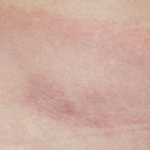“I’m looking for advice.” She shifted the left knee and grimaced ever so slightly. “Let me start at the beginning, two years ago, when I contracted Lyme disease …” She opened the binder. The fingers of her hands were slender and delicate, and as she licked her right index finger to turn the page, I assessed the left knee. The normal anatomy was distorted. Fluid within the joint bulged outward, making it difficult, if not impossible, for her to fully extend the joint.
“One morning, I was bitten by a tick. I didn’t think much of it at the time; my property is infested with ticks, it’s overrun with ticks. I’m constantly pulling them off the dogs. But this one was embedded, and it was quite a process to remove it.”
The knee held, I estimated, more than a cup of synovial fluid—roughly two full large syringes. Behind her was a cane. I’m not surprised. An effusion that large must make it difficult to walk.
“Well, I went to the doctor,” she continued, “and showed her the remains of the tick. We both agreed it was a deer tick, not the larger, innocuous dog tick, and she gave me a single dose of doxycycline in a dose of, let me see here,” she flipped to a tab titled, TREATMENT, “that would be Aug. 24 slightly more than two years ago. Here it is: 200 mg of doxycycline.”
“And did that help?” I asked.
“Evidently not.” She hiked up her ruffled skirt for me to better view the affected knee. “Can you imagine, a single dose of doxycycline? What was the doctor thinking?”
My thoughts: The standard dose for prophylaxis against Lyme disease after pulling off an embedded tick is indeed 200 mg of doxycycline.
I stared at her mid-thigh, trying to be discreet. There was a reddened, slightly scaly, quarter-sized rash on the anterior inner aspect. I leaned forward to get a better look. She tugged the skirt down, covering the rash, so I placed a hand on the knee. “There’s a large amount of fluid in this knee. Has it ever been aspirated?” I asked.
“Once. An orthopedic surgeon insisted on giving me a cortisone shot. But we’re getting ahead of ourselves.” She took off her sunglasses and cleaned them thoroughly before going on.
At a guess, she was 45 or so, red hair, blue eyes. Crow’s feet fanned out from the outer margins of her eyes. On the upper right forehead, a patch of discolored, slightly irregular skin looked pre-malignant, probably an actinic keratosis related to sun damage. With her left hand, she reached up and ran her fingers through her hair. There. Another patch of flaky, scaly red skin flashed at the elbow before disappearing beneath a sweater sleeve.


